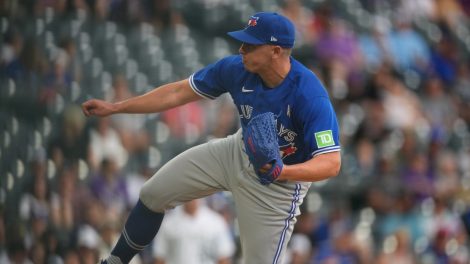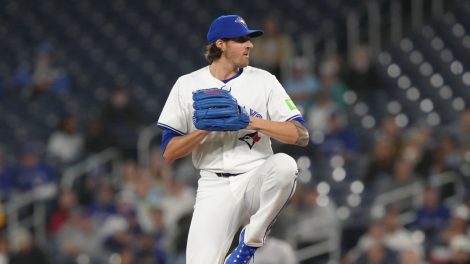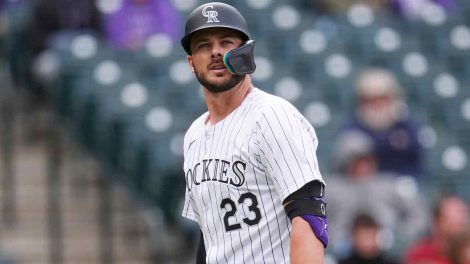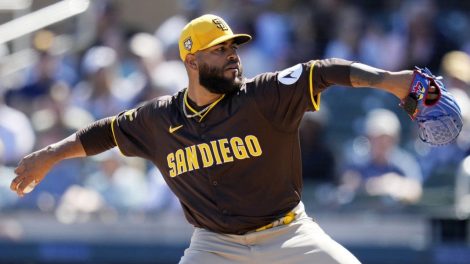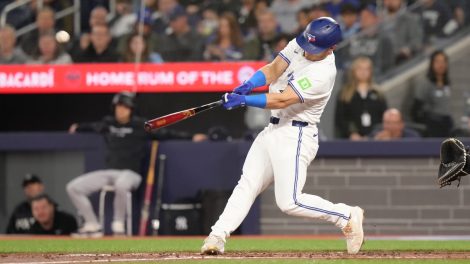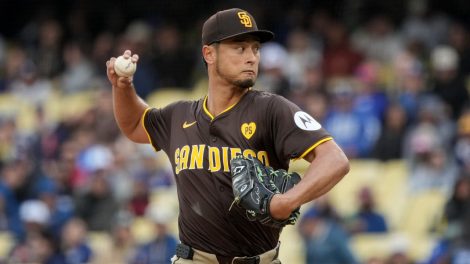TORONTO – At some point, the Toronto Blue Jays are going to have to make a leap. The how, the when, they’re TBD, and really that’s the overriding matter now before the franchise. No rebuild is accomplished solely with pieces from within, and there’s an obvious deficiency on the pitching side. Some of it will emerge in-house, sure. But to get over the top, they’ll have to jump, both financially and in prospect capital, and timing that right to ensure a successful landing on the other side may be the trickiest task yet for president and CEO Mark Shapiro.
There are multiple simultaneous challenges to work through here, starting with the continued development of a promising position player core, to the transitionary period in which opportunity is given on the pitching side, to the expectation the he runs a responsible business.
Mistiming either of the first two ensures the third doesn’t happen, although another off-season without any substantive additions also complicates the business end and risks creating a crisis of consumer confidence, especially after a touchy and emotional trade deadline.
Blend all that together and it’s a difficult tightrope for Shapiro to walk given that, as he explained during an extensive and forthright hour-long session with media Thursday, “the only directive from ownership (Rogers Communications Inc., which also owns Sportsnet) is to run a business that doesn’t lose money, which means, obviously, payroll’s going to reflect revenue, and revenues are down because attendance is down.”
“Part of the plan from Day 1 and part of the understanding has been that there will be a time that we need to outspend, outpace revenue with spending on players,” Shapiro continued during his first extensive public comments since the trade deadline. “When? They’ll rely on us, they’ll rely on Ross Atkins, they’ll rely on Joe Sheehan, Mike Murov and me, the rest of our front office to say, ‘OK, we are close enough to a contending team that we need to go out and spend on players now that supplement this core.’ We’ll have the flexibility to do that starting this off-season, because when you’re young, by nature your payroll goes down, but I think the key is as we start to mature, and guys start to get in their prime, they’re going to become more expensive, we need to make sure we A, keep those players in place and B, we add the necessary pieces at the right time.”
In simplified terms, everything needs to be calculated to achieve maximum leverage, and one or two bad contracts may impact the Blue Jays eventually if they try to lock in someone like Vladimir Guerrero Jr., or Bo Bichette.
Thus, be smart about when you shoot your shot.
[snippet id=4722869]
Still, the danger in being overly cautious is in potentially waiting too long and not taking advantage of an emergent core while its costs are contained over the next three years.
As Shapiro mentioned, the Blue Jays have an overwhelming amount of financial flexibility to work with this winter, as the only guaranteed money on the books belongs to Randal Grichuk ($13 million), Lourdes Gurriel Jr. ($2.929 million) and the released Troy Tulowitzki ($14 million plus a $4 million buyout). Closer Ken Giles is their only significant ticket in arbitration, and he’s a candidate to be traded, while Matt Shoemaker, who is also eligible, could potentially be non-tendered and brought back at a reasonable cost.
Even with payroll sure to drop below $100 million barring a surprising leap this winter – a function both of where the roster is at and where the club’s diminished revenue projections lie – the Blue Jays should have a good amount of money to work with.
“If we spend $25 million on contracts this winter, it probably is not going to be outside of our projected revenue because of the rest of our payroll,” Shapiro conceded.
So, rather than leaping this off-season, perhaps the play for the Blue Jays is a hop, a move for a middle-tier starter who can stabilize things for 2020 with enough in the tank to still provide some value once the competitive window really starts to open in 2021.
Rather than thinking upper-tier arms like Gerrit Cole and Dallas Keuchel at this point – unlikely without a major overpay anyway, for a number of reasons – someone more like a Kyle Gibson, Rick Porcello, Tanner Roark, Alex Wood or, on the higher end of that range, Zack Wheeler.
In that way, the 2020 staff is deeper, there’s more insulation for the kids but still opportunity as well, and there’s some depth in place for when the competitive window opens while not pushing the pay scale out of whack.
Augmenting progressively is an approach the San Diego Padres have employed the past two winters, adding big-name free agents Eric Hosmer and Manny Machado to speed their rebuild. The Chicago White Sox tried to do something similar this winter when they pursued Machado and Bryce Harper in free agency.
The Chicago Cubs and Houston Astros, on the other hand, waited until their team was closer to the tipping point before making bold external adds. They both did it successfully. The Philadelphia Phillies, who added Jake Arrieta two off-seasons ago and signed Harper this spring, to this point have not.
“You always want to be opportunistic, so stay open-minded to acquiring,” Shapiro said when asked about the possibility of jumping the timeline the way San Diego has. “We’ve made calls, even this trade deadline, on acquiring players, on adding players even now. So it’s a little bit about being opportunistic and there will be a time I think we have to (add).”
So much of that hinges on when the pitching develops.
Shapiro identified three waves in the current crop of Blue Jays arms. Trent Thornton, Thomas Pannone, Sean Reid-Foley, Jacob Waguespack and the injured Ryan Borucki, who visited Dr. James Andrews in Florida on Thursday, are here. Top prospects Nate Pearson, Anthony Kay, Julian Merryweather, Patrick Murphy, Yennsy Diaz, T.J. Zeuch and Hector Perez are an on-the-cusp group behind them. Further down the system are Eric Pardinho, Alek Manoah, Simeon Woods Richardson, Maximo Castillo, Adam Kloffenstein, Joey Murray and Zach Logue.
“In my mind, it’s been like we’ve got to figure out at a minimum three starters from that entire group in a championship window,” he said. “And then recognize that we’re going to either sign for or trade for a couple starters, that’s just the reality. And then some of those guys will end up being bullpen guys, that’s just what happens as well. Some will get hurt because pitching is a game of attrition, that’s just the nature of it. And there will probably be a name or two that, like a Joey Murray that no one was talking about a year ago, that comes out of nowhere and factors into this that I’m not even mentioning.”
And so it becomes a function of when the current crop of Blue Jays have done enough to make everyone believe the time is right.
[relatedlinks]
A cautionary tale exists from the turn of the century, when the Blue Jays developed a tremendous wave of young talent highlighted by Carlos Delgado, Shawn Green, Alex Gonzalez, Shannon Stewart and Vernon Wells on the position player side, and Roy Halladay, Chris Carpenter and Kelvim Escobar on the pitching side, but were never quite deep enough.
The New York Yankees and Boston Red Sox were monsters then, just as they’re monsters now, although the always talented Tampa Bay Rays are in the current mix, too.
Had the Blue Jays added earlier or more aggressively back then, would things have turned out differently? Maybe, maybe not, but the game has changed since then, as has the business.
The aim of front offices everywhere is to work objectively, and the goal is not only to get better with additions, but to add and get better “with players that are meaningful to those wins.”
“Basically, I would say all wins aren’t created equal,” Shapiro continued. “A player who’s a three-win player who takes you from 82 to 85 wins probably doesn’t move that (financial) needle. But if you’re at 87 wins and it takes you from 87 to 90, does that make sense? So it’s more like when we’re at that point, when you can get the player who helps take you from a good team to a team that’s a potential championship team, and we need to go out and get that player, that (financial) support will be there.”
All of which makes timing the leap so hard. So many different pieces need to align and no one wants to be up in the air, unsure of whether there’s enough momentum to get to the other side.



